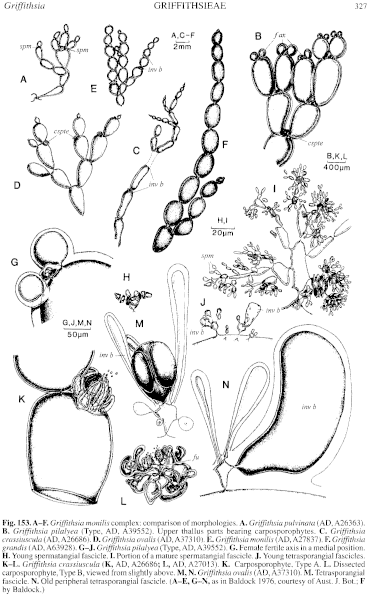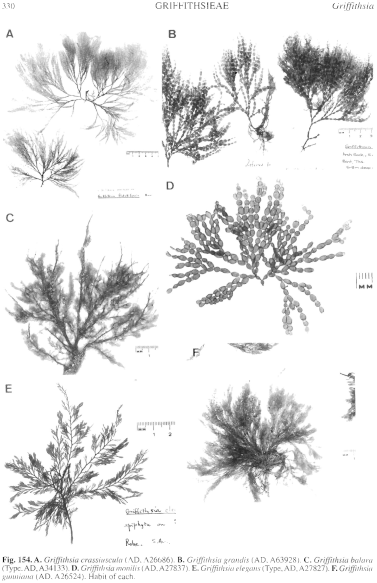|
|
|
|
|
|||||||||||
|
Electronic Flora of South Australia Species Fact Sheet
Phylum Rhodophyta – Order Ceramiales – Family Ceramiaceae – Tribe Griffithsieae
Selected citations: Guiler 1952: 95. Sonder 1881: 11.
Thallus (Fig. 154B) dark red, 8–14 cm high, branching lax, irregularly subdichotomous 3–5 times, ecorticate, distinctly moniliform. Attached by rhizoids; epilithic. Structure. Cells (Fig. 153F) near the thallus apex globose, 2–3 mm in diameter, without a short proximal neck, very large in mid thallus, ovoid, 3–4 mm in diameter and L/D 1.5–2, basal cells cylindrical, 0.8–1.4 mm in diameter and L/D 2.5–3; filaments strongly constricted between cells, gradually attenuate towards apices.
Reproduction: Gametophytes dioecious. Procarps unknown; hair-like, synchronic laterals associated with reproductive structures inconspicuous; hypogenous cell of carposporophyte producing 4–7, two-celled synchronic involucral branches, the lower cells small, terete, the terminal cells incurved, large, 400–450 µm in diameter and L/D 1.8–1.9, and often furcate apically. Spermatangia borne on whorls of numerous, minute, polychotomous fascicles from the upper ends of vegetative cells near the thallus apex, clustered in the constrictions between cells; involucre absent.
Tetrasporangia globose-lachrimiform, 50–60 µm in diameter and L/D 1–1.5, borne successively in clusters of 3–4 on whorls of numerous, minute, terete or urceolate pedicels, tetrahedrally divided; fascicles internal to a cluster (Fig. 155I, left) each bearing an ovoid sterile cell similar in size to tetrasporangia, those peripheral to a cluster (Fig. 155I, right) each bearing inflated, incurved, clavate, 1-celled involucral branches, 50–60 µm in diameter and L/D 2–3.
Type from Port Phillip, Vic. (Wilhelm, in Herb. Kützing, L, 941, 61 ... 115).
Selected specimens: Waldegrave I., S. Aust., 23m deep (Shepherd, 11.v.1971; AD, A38738). Port Turton, S. Aust., 8–10m deep (Kald, 5.ix.1970; AD, A37260). Investigator Strait, S. Aust., 31 m deep (Watson, 23.i.1971; AD, A41105). Godfrey Is, Guichen Bay, S. Aust., 2–3m deep (Shepherd, 15.ii.1975; AD, A46108). Crawfish Rock, Westernport Bay, Vic., 3m deep, (Watson, 15.ix.1968; AD, A32758). San Remo, Vic., drift (Sinkora, A2216, 19.x.1975; AD, A48537). Deal I., Bass Strait, 40m deep (Shepherd & Lewis, 9.v.1974; AD, A45262). Ninepin Point, Tasmania, 8m deep on pebbles (Sanderson, 21.x.1994; AD, A63928).
Distribution: Waldegrave I., S. Aust. to Westernport Bay, Vic., and around Tasmania, at depths of (3–) 7–40 m.
Taxonomic notes: Previously considered to be a large form of G. monilis by Baldock (1976, p. 517), G. grandis differs in its distribution and morphology (see Fig. 153E, F). G. grandis differs from G. ovalis which also has very large, ovoid cells, in having a lax branching pattern, dark red colour, and tetrasporangia about half the diameter of G. ovalis; it also occurs deeper than G. ovalis.
References:
BALDOCK, R.N. (1976). The Griffithsieae group of the Ceramiaceae (Rhodophyta) and its southern Australian representatives. Aust. J. Bot. 24, 509–593.
GUILER, E.R. (1952). The marine algae of Tasmania. Checklist with localities. Pap. Proc. R. Soc. Tasmania 86, 71–106.
KÜTZING, F.T. (1862). Tabulae Phycologicae. Vol 12. (Nordhausen.)
SONDER, O.W. (1881). In Mueller, F., Fragmenta Phytographiae Australiae. Supplementum ad volumen undecinum: Algae Australianae hactenus cognitae, pp. 1–42, 105–107. (Melbourne.)
The Marine Benthic Flora of Southern Australia Part IIIC complete list of references.
Publication:
Womersley, H.B.S. (24 December, 1998)
The Marine Benthic Flora of Southern Australia
Rhodophyta. Part IIIC. Ceramiales – Ceramiaceae, Dasyaceae
©State Herbarium of South Australia, Government of South Australia
Illustrations in Womersley Part IIIA, 1998: FIGS 153F, 154B, 155 I.

Figure 153 enlarge
Fig. 153. A–F. Griffithsia monilis complex: comparison of morphologies. A. Griffithsia pulvinata (AD, A26363). B. Griffithsia pilalyea (Type, AD, A39552). Upper thallus parts bearing carposporophytes. C. Griffithsia crassiuscula (AD, A26686). D. Griffithsia ovalis (AD, A3731.0). E. Griffithsia monilis (AD, A27837). F. Griffithsia grandis (AD, A63928). G–J. Griffithsia pilalyea (Type, AD, A39552). G. Female fertile axis in a medial position. H. Young spermatangial fascicle. I. Portion of a mature spermatangial fascicle. J. Young tetrasporangial fascicles. K–L. Griffithsia crassiuscula (K, AD, A26686; L, AD, A27013). K. Carposporophyte, Type A. L. Dissected carposporophyte, Type B, viewed from slightly above. M, N. Griffithsia ovalis (AD, A37310). M. Tetrasporangial fascicle. N. Old peripheral tetrasporangial fascicle. (A–E, G–N, as in Baldock 1976, courtesy of Aust. J. Bot.; F by Baldock.)

Figure 154 enlarge
Fig. 154. A. Griffithsia crassiuscula (AD, A26686). B. Griffithsia grandis (AD, A63928). C. Griffithsia balara (Type, AD, A34133). D. Griffithsia monilis (AD, A27837). E. Griffithsia elegans (Type, AD, A27827). F. Griffithsia gunniana (AD, A26524). Habit of each.

Figure 155 enlarge
Fig. 155. A–C. Griffithsia monilis var. monilis (AD, A26385). A. Procarp at fertilization. B. Procarp soon after fertilization. C. Young carposporophyte. D–H Griffithsia monilis var. cincta (AD, A63201). D. Fertile axis with a single supporting cell bearing 2 carpogonial branches. E. Young spermatangial fascicle. F. Peripheral spermatangial fascicle. G. Inner tetrasporangial fascicle. H. Peripheral tetrasporangial fascicle. I. Griffithsia grandis (AD, A63928). Types of tetrasporangial fascicle. (A–H, as in Baldock 1976, courtesy of Aust. J. Bot.; I by Baldock.)

|
Email Contact: State Herbarium of South Australia |

|